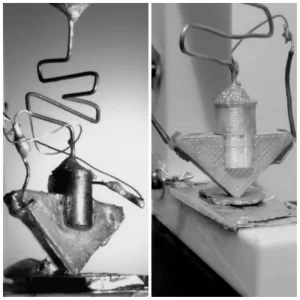This year's Nobel Prize in Physics was awarded a few days ago to three scientists (Alain Aspect, John F. Clauser and Anton Zeilinger) for their work on "quantum entanglement"—what Albert Einstein called "spooky action at a distance"—whereby measurement of the state of one particle can instantaneously change the measured state of another particle, even if they are separated by light-years.
At my 50th (gulp!) college reunion this year, I went to a lecture, one of the many organized by the reunion staff for interested alumni, by Prof. Stephen Girvin, the Eugene Higgins Professor of Physics at Yale. The subject was quantum computing, something I had been trying, with absolutely no success, to understand for a couple of years.
The lecture was outstanding; though I would hardly say that I came away understanding exactly how quantum computers work, I did get at least get a glimpse of the underlying principles, which was considerably more than I had had before.
I found it reassuring to read that in a recent interview, one of the prize-winners, John Clauser, said, "I confess even to this day that I still don't understand quantum mechanics, and I'm not even sure I really know how to use it all that well…"
There was, though, a moment of truly glorious illumination. Girvin was making the following rather interesting point: Most people understand that theoreticians in physics (and the other natural sciences) have no idea of, and give no thought to, any possible practical applications of their work; they're trying to understand how the universe is put together and how it works, simply for the sake of understanding how the universe is put together and how it works.
Girvin's point, though, was that even the engineers—the ones whose job it is to translate theory into actual things—can't possibly foresee the practical consequences of their work, either. He illustrated this point with the example of the transistor.
When John Bardeen, Walter Brattain, and William Shockley invented the first transistor in 1947 :

(shown above, for which they were awarded the Nobel Prize in 1956), they could not possibly, in their wildest dreams, have imagined how ubiquitous and fundamentally transformative their device would become. "How many transistors," Girvin asked the audience, "do you think were produced around the globe in 2020?"
Pause. And then he flashed the answer on the screen: 20 trillion per second.
There as a very audible gasp from the 100 or so people in the audience; I don't think I've ever heard anything quite like it before. It seems impossibly large; it can't possibly be true.
But it is. While I thought it highly unlikely that the Eugene Higgins Professor of Physics at Yale would put forth a number like that without having checked it pretty carefully, I did a little double-checking myself and it checks out. Consider: The most recent iPhone contains around 15 billion transistors. Apple sold around 220 million iPhones in 2021. That means around 10 100 billion transistors were produced each second just for iPhones. Add the hundreds of millions of other phones, plus all the refrigerators, air conditioners, PCs, automobiles, televisions, etc. etc. etc., every one of which contains many millions or billions of transistors, and you can pretty easily see where the 20 trillion/second figure comes from.
I'm not sure I know what it means, but something tells me it means something important.
The post Today's Physics News appeared first on Reason.com.







